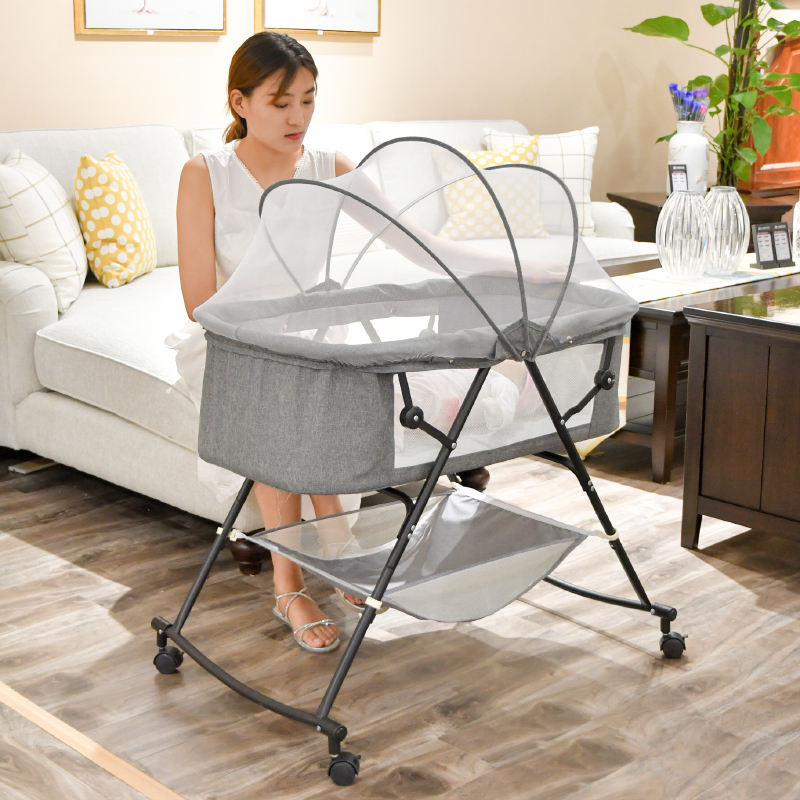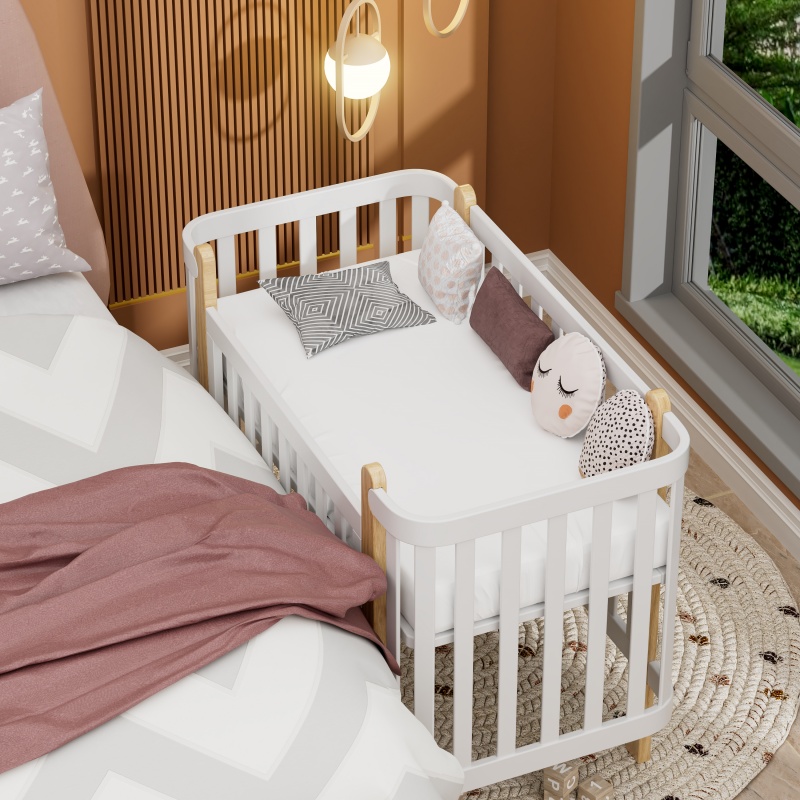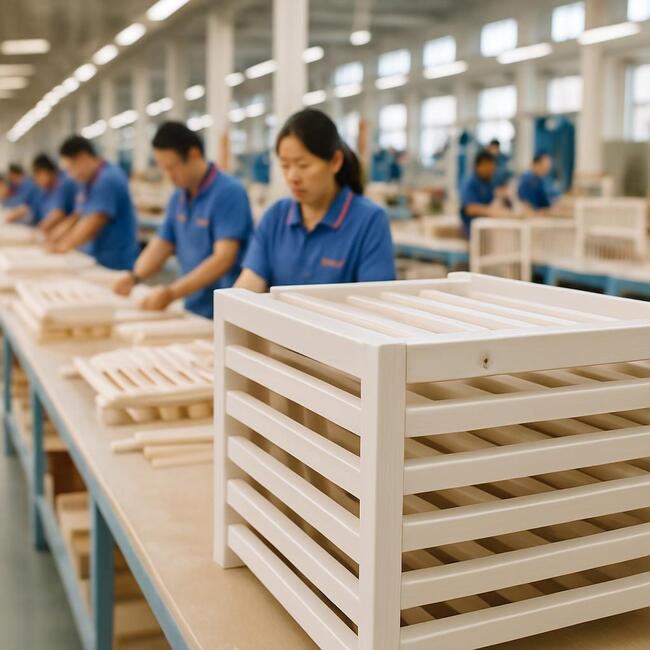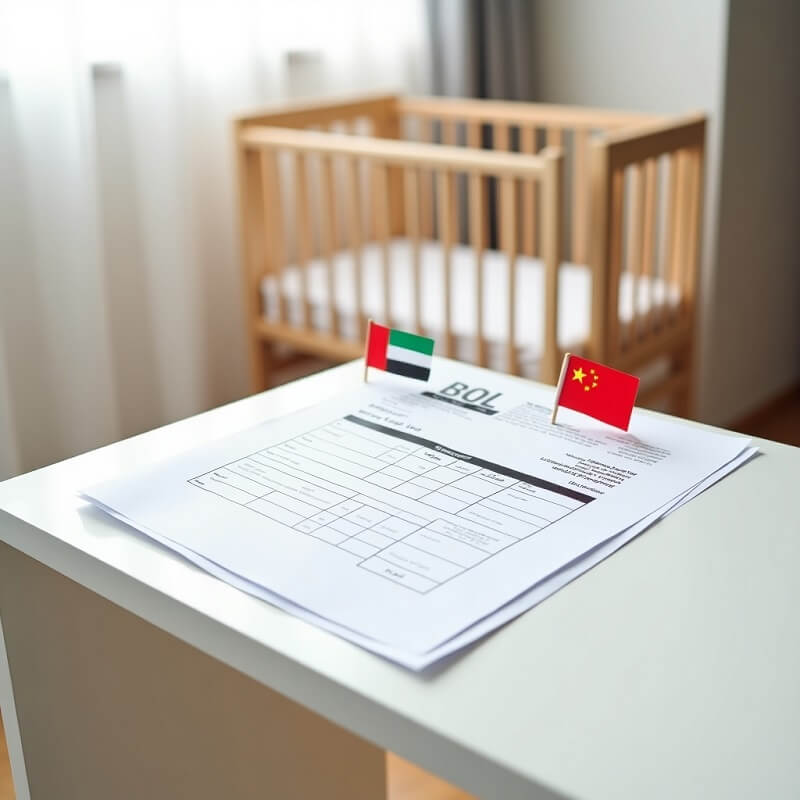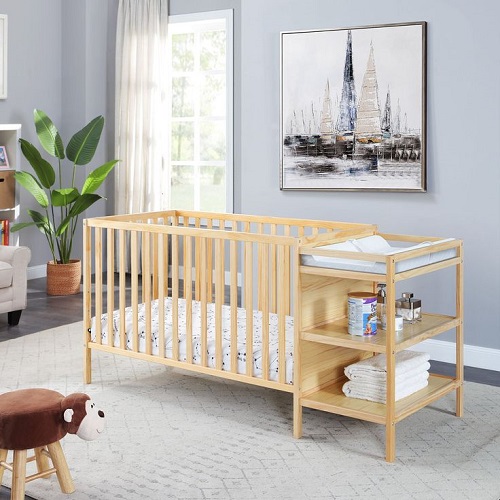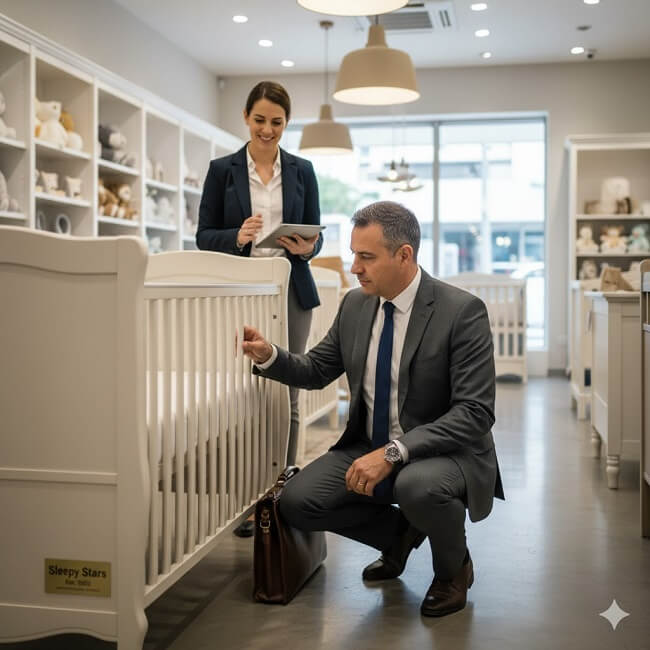When it comes to creating a safe and comfortable sleeping environment for your newborn, choosing between a crib and a bassinet can be a tough decision.
In this article, we will explore the key differences between a crib and a bassinet, discuss whether the baby should sleep in a crib or a bassinet, and provide tips for choosing the right option for your baby’s needs.
What is a Crib?
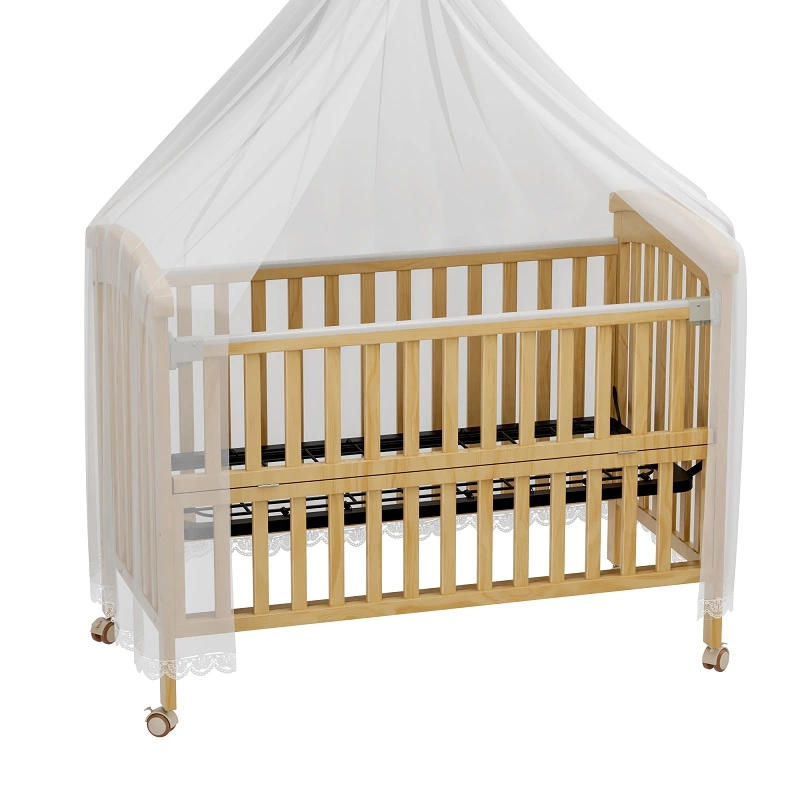
Definition and Features of a Crib
A crib is a large, enclosed bed designed for infants and toddlers. It typically features high sides, a sturdy structure, and a wide variety of designs. Its standard dimensions are 52 inches long x 28 inches wide (132 cm x 71 cm).
Crib designs feature slatted sides to promote airflow and visibility, allowing parents to easily monitor their child. Modern cribs often include adjustable mattress heights, allowing parents to lower the mattress as their baby grows and begins to stand or climb.
Additionally, many cribs have built-in drawers for storage or a removable changing table, further enriching the functionality of this nursery furniture piece.
Pros and Cons of Crib
Pros
- Safety and Security: Cribs are carefully crafted with sturdy structures and raised edges to prevent babies from rolling out or getting stuck. They are a very safe sleeping environment for babies.
- Long-term Use: Many cribs are convertible, which means they can be transformed into a toddler bed, sofa bed, or even a full-size bed, extending their lifespan beyond infancy.
- Comfort: Cribs provide babies with ample room to stretch out and move comfortably while sleeping. They provide a firm and supportive sleeping surface that promotes healthy sleeping habits and proper spinal alignment.
- Versatility: Cribs come in a variety of designs, including convertible options, co-sleeping features, storage solutions, built-in storage, and more.
- Independence: Infants who sleep in cribs from an early age may have an easier transition to independent sleeping as they grow up.
Cons
- Higher initial cost: Cribs are often more expensive than other newborn sleeping options. High-quality cribs with safety certifications and convertible features can be particularly expensive.
- Space requirements: Cribs take up a fair amount of space, which can be a limitation for families with limited living space or a small nursery. Fitting a crib into a shared bedroom or smaller apartment can be challenging.
- Lack of portability: Standard cribs are stationary, bulky, and not easily moved from room to room, making them unsuitable for families who travel.
- Assembly and maintenance: Installing a crib can be time-consuming and requires tools. Regular maintenance, such as tightening screws and cleaning, is necessary to ensure safety.
What is a Bassinet?
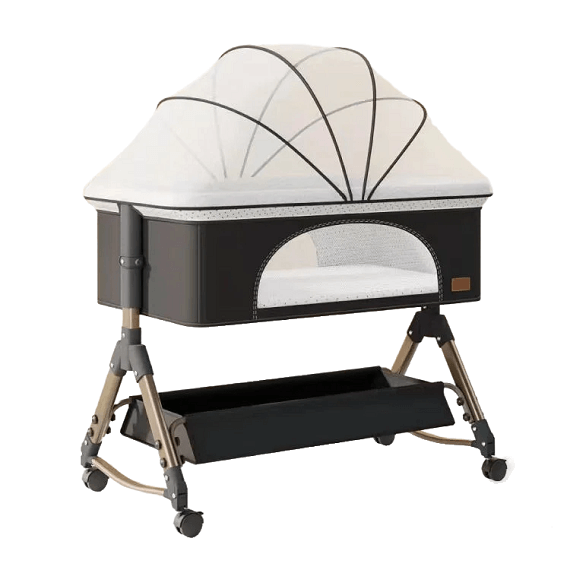
Definition and Features of a Bassinet
A bassinet is a smaller, more portable sleeping space with breathable mesh sides, often used for newborns. It usually has lower sides and is designed to be placed next to the bed for easy nighttime use.
Most bassinets are portable, so parents can easily move them from room to room. This allows parents to keep their baby close during nighttime feedings or naps.
Many bassinets are designed with baby soothing features, either manual or automatic, to help soothe your baby to sleep or calm a crying baby.
Pros and Cons of Bassinet
Pros
- Portability: Bassinets are lightweight and easy to carry, giving you peace of mind that your baby is always by your side.
- Space-saving design: Bassinets are great for small spaces or for parents who prefer to keep their baby in their bedroom for the first few months.
- Co-sleeping: Many bassinets are designed to attach to the side of a parent’s bed for safe co-sleeping. This can promote bonding between parent and baby and make nighttime breastfeeding more convenient.
- Gentle rocking or vibration: Bassinets with features like gentle rocking or vibration provide comfort that can help soothe a fussy baby to sleep.
- Easy access: Bassinets have low sides, so parents can easily reach and pick up their baby without having to bend over or strain. This is especially helpful for mothers who have had a C-section or are recovering from childbirth.
Cons
- Short-term use: Bassinets are designed for newborns and often have a weight or size limit specified by the manufacturer. Bassinets grow relatively quickly and often outgrow a bassinet within the first few months of life.
- Safety concerns: Bassinets are often less sturdy than cribs, which can pose a safety risk as babies become more active and mobile.
- Less flexibility: Unlike cribs, which can be converted into toddler beds or other furniture, bassinets have only one purpose and cannot be repurposed once babies outgrow them.
- Space limitations: As babies grow, bassinets may not provide enough room for them to stretch out and move comfortably. This can be a problem for larger or more active babies.
Difference Between Crib and Bassinet
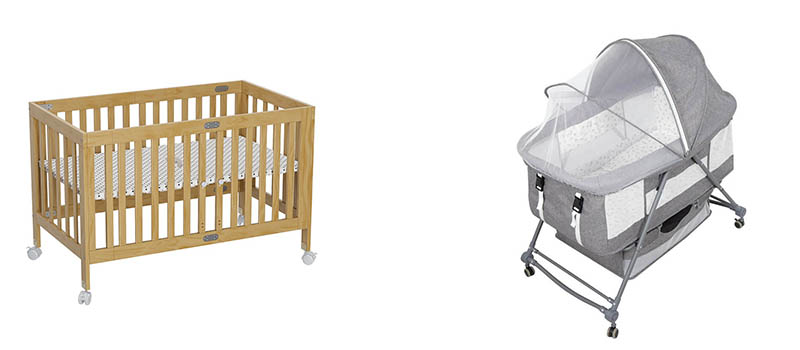
Both cribs and bassinets can provide a safe sleeping environment for babies, but they differ in many ways.
While we have already described the features, pros, and cons of cribs and bassinets in depth above, this section uses a list to summarize the differences between the two more systematically and intuitively.
Understanding these differences can help parents make an informed decision based on their lifestyle and the comfort and safety of their baby.
| Feature | Crib | Bassinet |
| Size | Larger, takes up more space | Newborns up to 4-6 months |
| Portability | Fixed, immobile | Lightweight and easy to move around |
| Storage | May include built-in storage options | Limited storage, but some models include small pockets |
| Cost | Generally higher due to size and features | Usually lower cost, ideal for short-term use |
| Versatility | Often convertible to toddler beds or daybeds | Limited versatility, used only as a newborn sleep space |
| Weight | Heavier and bulkier | Lighter, easier to carry or move around |
| Adaptability for Parents | May require bending over to interact with baby | Often positioned at a convenient height for easy interaction |
Factors to Consider When Choosing
Babies spend most of their time sleeping, and even if the ultimate function of different products is the same, for the comfort of children and the harmony of parenting families, it is reasonable to spend a little more time thinking about which sleeping tool is best for your baby.
Here are the factors you need to consider when choosing:
Baby Age
A bassinet is suitable for newborns under 4-6 months old. It provides a comfortable and warm environment for babies who have not yet turned over or pushed up. A crib is suitable for use from birth to infancy and provides more space.
Space Availability
A bassinet is perfect for families living in small spaces such as apartments. The compact size can fit it into a bedroom with limited space. A crib requires more space, especially a full-size crib, so it is more suitable for larger nurseries.
Budget
If you are on a limited budget at the moment, choosing a bassinet is a good solution, usually less expensive than a crib.
Co-sleeping Preference
If you want to be able to take care of your baby and breastfeed at any time, then choose a bassinet. Many bassinets are designed for co-sleeping arrangements, and the side panels can be lowered for easy access by the baby.
Usage Plan
If you are long-term or do not want to buy too much baby furniture in your plan, it is recommended to choose a crib, which is still suitable for babies after 6 months, without having to buy new sleeping tools. After the baby grows up and is no longer suitable for the crib, its sturdy and durable characteristics can also help you pass it on to the next child.
Recommended User-Friendly Crib and Bassinet Styles
Crib Styles
Convertible Cribs: Convertible cribs are versatile and can be converted into different bed types, such as toddler bed, sofa bed, or even a full-size bed. You can choose a 3-in-1 crib, 4-in-1 crib, or 5-in-1 crib, depending on your needs.
Mini Cribs: Mini cribs are smaller than standard cribs and are ideal for smaller nurseries or homes with limited space. They are increasingly being used as second cribs for travel or in guest rooms.
Adjustable Cribs: Adjustable cribs feature an adjustable mattress height to accommodate your baby’s growth and development stage. Look for a crib with multiple mattress height settings that can be easily adjusted without tools or complicated assembly.
Bassinet Styles
Co-sleeper Bassinets: These baby bassinets are designed to lower on one side to the adult bed, allowing you to be as close to your baby as you feed and soothe him/her during the night while maintaining a separate sleeping surface.
Portable Bassinets: Portable bassinets are lightweight and often have features like a foldable frame or carrying handles, making them easy to move around the house or take with you when traveling.
Swinging or Rocking Bassinet: These bassinets have a built-in rocking or rocking feature that gently soothes babies to sleep, and the movement mimics the comforting rhythm of being held or rocked, which can calm babies.
Smart Bassinets: Smart bassinets use technology to help soothe babies. Some models include automatic rocking, vibration, or lullabies, while others come with apps to track sleep patterns or monitor babies.
Playard Bassinets: A playard bassinet is a two-in-one product that can be used as both a bassinet and a playpen. It often has a removable bassinet insert for use with newborns, and the playpen can later be used as a play space as the baby grows.
When and How Does a Baby Transition from a Bassinet to a Crib?
When to Transition?
The age at which babies transition from a bassinet to a crib can vary. Most babies outgrow a bassinet between 4-6 months old or when they reach the manufacturer’s weight limit.
As babies grow, some become more active and restless. Bassinets usually have lower sides than cribs and offer less space. If your baby rolls over, gets on his hands and knees, or shows signs of trying to climb out of the bassinet, it’s time to transition to a crib.
How to Transition?
Start by letting your baby nap in the crib to help them adjust to their new sleeping environment. Get them familiar with the comfort and size of the crib.
Help your baby build a sense of familiarity before bed, such as reading a book, singing a lullaby, or using a comfort object. Consistency will help your baby feel at ease.
Be patient during the transition. They’re new to the world, and everything takes time to adjust. You need to be persistent and encouraging.
Conclusion
Choosing between a crib and a bassinet for your baby’s sleep needs is a personal decision that depends on various factors. Understanding the differences, advantages, and disadvantages of each option can help you make an informed choice.
By weighing these factors and exploring the user-friendly styles of both cribs and cradles, you can create a safe and comfortable sleeping environment for your little one.
Recommended Related Articles:

